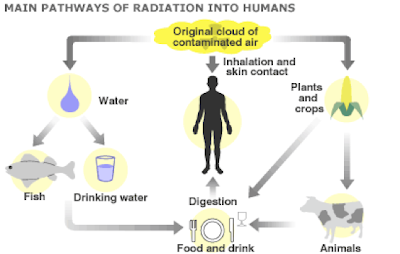Hello, after last week’s rather sombre blog
about Chernobyl I thought this week I would start on a slightly lighter note,
not an easy thing to do when your weighing up the twin threats of nuclear power
and climate change, but I’ll try!
So what better place to start given its
contemporary relevance, than last week’s news that the government has given the
go-ahead for the UK’s first new nuclear power station in a generation, and the
first in Europe since Fukushima; welcomed in typically mixed fashion by the British
press. Funnily enough very little of the
debate even mentioned what it could mean for global warming, I heard the words
‘carbon free’ a couple of times, but most of the time the debate focused on the figure
of £90, which is still ringing in my ears a week on.
 |
| Hinkley Point in Somerset-already the site of the disused Hinkley Point A and the still operational B power stations (Source: Guardian,2013) |
So what is this £90 figure, well it is
£92.50 to be precise and is the strike price of every megawatt hour of energy
the new power station will generate; basically the fixed price, at which EDF (the
French energy giant building the power station), has agreed to sell to the government, not the consumer!
Now many newspapers/analysts have lamented
this figure and at face-value it can’t be denied it looks bad. It is three
times more than the EDF’s original proposal and over £30 more expensive than
the current wholesale price, which in the context of the recent price hikes by
companies such as British Gas isn’t exactly music to the ears of consumers
moving into winter (BBC, 2013).
However before we judge Hinkley C as an economic,
consumer and environmental failure as John Sauven executive director of Greenpeace did last week (Greenpeace, 2013). It should be remembered that the plant will not be
in operation until 2023,when hopefully we will all be much richer and the cost
will not differ so greatly from good old gas/coal generated energy. Also when
compared with other carbon free alternatives it is around a similar price to
wind and a staggering 3 times cheaper than tidal and wave.
 |
| Some of the high costs of renewables are due to lack of investment, in the future prices for tidal, wave and solar may well fall (Source:BBC, 2013) |
It cannot be denied that cost is a huge
issue in tackling climate change; if renewables and carbon-free energy were
cheap I’m sure we would see a lot more wind turbines and solar panels around us, but
as the infrastructure isn’t in place rising energy prices are perhaps an
obstacle that cannot be avoided.
The deal at Hinkley does not look water
tight, the loan guarantees given to EDF and the Chinese are ambiguous and if
they amount to 70% of the debt raised to fund the 14 billion cost of the reactors, they
could force George Osbourne to go back on his promise to British tax payers (Guardian, 2013).
"If it wasn't Chinese investment or
French investment, it would have to be the British taxpayer. I would rather
British taxpayers were spending their money on our schools and hospitals and
those things, and let's get the rest of the world investing in our energy"
There is also uncertainty about how fixed
the price of £90 will remain with inflation and changes in the uranium
price. Yet despite all this I tend to share
the view of Simon Jenkins in the Guardian who referred to Hinkley as:
"a messy and bad deal for UK energy users,
but it’s a decision. And it’s cheaper than wind".
It is a gamble but it is also a major
switch to a ‘greener’ energy source albeit a non-renewable one. The station
will generate 7% of Britain’s electricity and release no CO2, something that has been widely ignored in the media. It is also creating
25000 jobs, which surely can’t be a bad thing.
Hinkley C is a microcosm of course of a
much larger debate, how we combat climate change and how we will generate
energy with ever diminishing coal and natural gas reserves. Nuclear is
obviously an option and I am pleased at least that the government is investing
in a carbon free energy source. However how the UK and other countries choose
to partition their energy usage in the future is the real burning issue (no pun
intended!). With more nuclear power stations throughout Europe and the world surely comes more environmental risk.
This video brings up some of the key issues surrounding Hinkley and nuclear power.
Thanks for reading!





